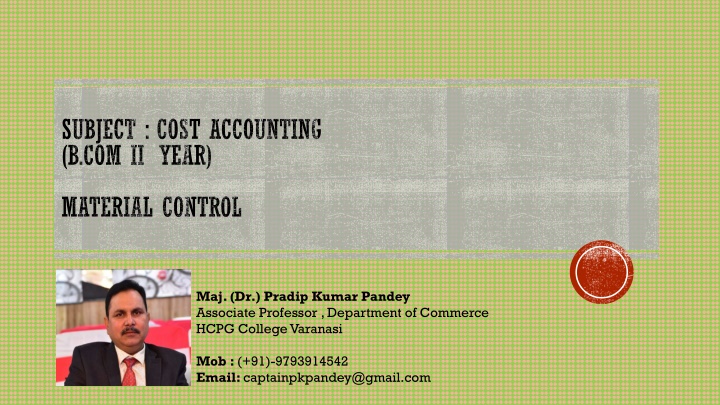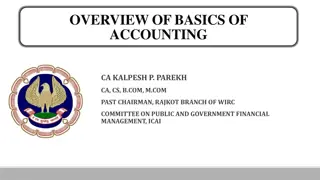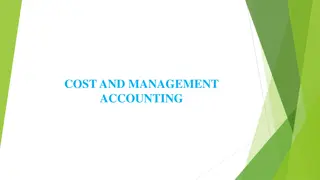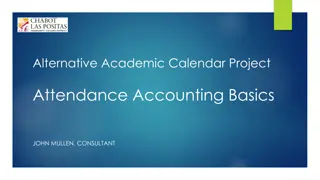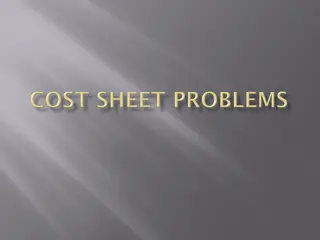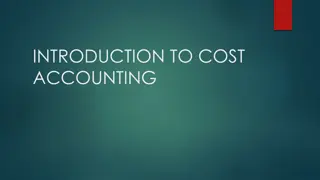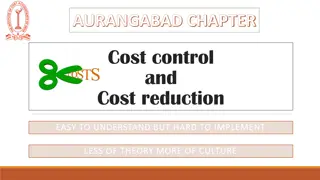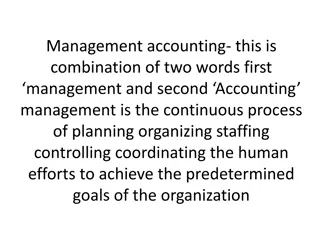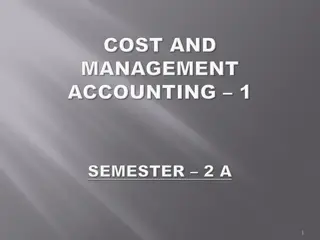Material Control in Cost Accounting
Material control in cost accounting involves maintaining a systematic control over the purchasing, storing, and utilization of materials to minimize costs while ensuring uninterrupted production. It encompasses aspects such as accounting and operational controls, aiming to balance the efficient use of materials with financial considerations. Techniques of material control focus on eliminating wastage and losses throughout the material management process.
Download Presentation

Please find below an Image/Link to download the presentation.
The content on the website is provided AS IS for your information and personal use only. It may not be sold, licensed, or shared on other websites without obtaining consent from the author.If you encounter any issues during the download, it is possible that the publisher has removed the file from their server.
You are allowed to download the files provided on this website for personal or commercial use, subject to the condition that they are used lawfully. All files are the property of their respective owners.
The content on the website is provided AS IS for your information and personal use only. It may not be sold, licensed, or shared on other websites without obtaining consent from the author.
E N D
Presentation Transcript
SUBJECT : COST ACCOUNTING (B.COM II YEAR) MATERIAL CONTROL Maj. (Dr.) Pradip Kumar Pandey Associate Professor , Department of Commerce HCPG College Varanasi Mob : (+91)-9793914542 Email: captainpkpandey@gmail.com
SYLLABUS : UNIT I Nature and Scope of Cost Accounting, Cost Vs. Management Accounting, Elements of Cost and their Classification, Methods and Techniques, Installation of Costing System, Concept of Cost Audit. Accounting for material: Material Control, Techniques, Pricing of material issues, Treatment of material losses. UNIT II Accounting for Labour: Labour Cost Control, Procedure, Labour Turnover, Idle Time and Overtime. Methods of Wage Payment-Time and Piece rates, Incentive Schemes. Accounting for Overheads: Classification and Departmentalization, Absorption of Overheads, Determination of Overhead rates, Under and Over Absorption and its treatment UNIT III Cost Ascertainment: Unit Costing Job Costing, Batch Costing, Contract Costing. UNIT IV Operating Costing, Process Costing, Cost Records: Integral and non-Integral System; Reconcilation of Cost and Financial Accounts.
MEANING: It can be defined as a comprehensive framework for the accounting and control of material cost designed with the object of maintaining material supplies at a level so as to ensure uninterrupted production but at the same time minimising investment of funds. In simple words material control is a systematic control over the purchasing, storing and using of materials so as to have the minimum possible cost of materials. Dimensions of Material Control: Material control has two dimensions 1. Quantity or unit control 2. Rupee or financial control Keeping in view unit control and financial control, material control should meet these two conflicting objectives 1. The maintenance of sufficient quantity of every item of material for efficient operations, 2. Maintenance of an inventory that is not detrimental financially
MATERIAL CONTROL: Aspects of Material Control: There are two aspects of material control as given below: 1. Accounting Aspect: It is concerned with maintaining documentary evidence of movement of materials at every stage right from the time sales and production budgets are approved to the point when material are purchased and actually used in production operation 2. Operational Aspect: It is concerned with the maintenance of material supplies at a level so as to ensure that material is available for use in production and production services as and when required by minimising the investment in material Need for Material Control: Following are the various objectives of material control: 1. Availability of materials 2. No excessive investment in materials 3. Reasonable price 4. Minimum wastages 5. No risk of spoilage and obsolescence 6. Ready information about availability of materials 7. Misappropriation of material 8. Right amount of payment to supplier
MATERIAL CONTROL: TECHNIQUES OF MATERIAL CONTROL: Material control aims at eliminating and minimising all kinds of wastage and losses while the materials are being purchased, stored, handled, issue or consumed. A number of technique mentioned below: 1. Level Setting 2. Economic Order Quantity 3. ABC Analysis 4. VED Analysis I. LEVEL SETTING: In order to have proper control on materials, the following levels are set: 1. Re-order Level: It is the point at which if stock of particular material in store approaches, the storekeeper should initiate the purchase requisition for fresh supplies of that material Ordering Level= Minimum Level + Consumption during the time required to get the fresh delivery Re-ordering level= Maximum Consumption * Maximum Re-order Period Minimum Stock Level= Re-ordering Level (Normal Consumption*Normal Re-order period) Maximum Stock Level= Re-ordering Level + Re-ordering Quantity (Minimum Consumption*Minimum Re-ordering period Danger Level= Average consumption* Maximum re-order period for emergency purchase
MATERIAL CONTROL: II. ECONOMIC ORDERING QUANTITY: The total cost of material usually consist of : Total Acquisition Cost + Total Ordering Cost + Total Carrying Cost 1. Total Acquisition Cost through buying is usually unaffected irrespective of the quantity of material ordered at one time unless quantity discounts are available. 2. Carrying Cost: It is the cost of holding the material in the store and includes: a. Cost of storage space b. Cost of bins and racks for storage c. Cost of maintaining the material d. Amount of interest payable on the money locked up in the materials e. Cost of spoilage f. Transportation cost g. Cost of obsolescence h. Insurance Cost i. Clerical Cost 3. Ordering Cost: It is the cost of placing orders for the purchase of materials and includes a. Cost od staff posted in purchasing department, inspection section and payment department b. Cost of stationery, postage and telephone charges Q= (2CO)/I Q=Quantity to be ordered; C= Consumption of material in units during a year O= Cost of placing one order including the cost of receiving the goods I= Interest payment including variable cost of storing per unit per year
MATERIAL CONTROL: III. ABC ANALYSIS: An analysis of the material costs will show that a smaller percentage of items of materials in the stores may contribute to a large percentage of the value of consumption of land and on the other hand a large percentage of items may represent a smaller percentage of the values of items considered. A category of items consist of only a small percentage i.e. about 10% of total items handles by the store but require heavy investment about 70% of inventory value because of their high price or heavy requirement or both B category of items are relatively less important- 20% of the total items of the materials handled by stores and % of investment required is about 20% of total investment in inventories C category- 70% of total items handled and 10% of value Thus, under this technique of material control, materials are listed in A , B and C categories in descending order based on money value of consumption
MATERIAL CONTROL: III. VED ANALYSIS: VED ( Vital, essential and desirable) analysis- This analysis is used primarily for control of spare parts. The spare parts can be divided into three categories- vital, essential or desirable keeping in view the criticality to production. Vital: The spares, the stock-out of which even for a short time will stop production for quite some time and where the cost of stock-out is very high. Essential: The spares, the absence of which cannot be tolerated for more than a few hours or a day. Desirable: Those spares which are needed but their absence for even a week or so will not lead to stoppage of production
